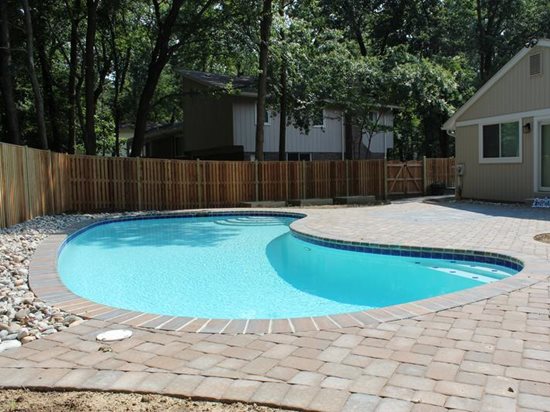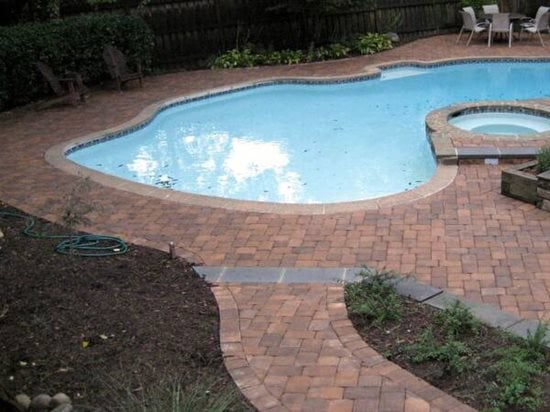- Concrete Paver Information
- Concrete Paver Pictures
- Patio Pavers
- Driveway Pavers
- Pool Deck Pavers
- Sidewalk & Walkway Pavers
- Porous and Permeable Concrete Pavers
- Installing Concrete Pavers
- Pavers Installation: Step-by-step overview of base compaction and mechanical installation
- Pricing of Concrete Pavers
- Paver Thickness & Specifications
- Other Resources
- Find Products: Pavers & Supplies
CONCRETE PAVERS FOR POOL DECKS: BENEFITS AND INSTALLATION
Benefits

Pavers are good for a pool deck because they are foot-friendly and provide good traction (NRC Landscape Construction, Vienna, Va.).
Concrete pavers are a great option for pool decks because they are durable; chlorine and salt resistant, and can provide the look of natural stone. Pavers also provide good traction and are comfortable underfoot, because the joints take on moisture that helps cool the surface.
Concrete pavers also come in a wide variety of colors, shapes, and sizes, allowing you to create designs that complement your pool’s shape and style. You can also use the pavers to build raised seat walls, pillars, or planter boxes that will coordinate with the pool deck itself.
Another advantage of using pavers for pool decks is that they can be spot replaced, if necessary. They can also be removed and replaced for electrical or plumbing repairs under the surface. Also, if you want to add on to your pool deck at a later time, it’s easy to install matching pavers and create a seamless transition.
One drawback of pavers is the cost, which tends to be higher than stamped and colored concrete. However, they offer great long-term value because of their ease of maintenance and resistance to cracking and settling.
Maintenance

Concrete pavers will resist the growth of algae and mildew in wet pool deck environments (NRC Landscape Construction, Vienna, Va.).
Because factory-made concrete pavers are very dense and nonporous, they resist the growth of algae and mildew in wet pool deck environments, especially if they are protected with a sealer.
To prevent erosion of the joints, use a sand with a polymer additive that binds and hardens it, usually eliminating the need for refilling them in 2 to 3 years.
Typically, the only regular maintenance required for a paver pool deck is sweeping and occasional rinsing to remove dirt and leaves.
Concrete pavers may settle in spots over time if they aren’t installed properly over a stable subbase. However, they can easily be reset with no noticeable patchwork. Simply remove the affected pavers, regrade and recompact the subbase, and reinstall the pavers.
Buying and installation tips
- To ensure the best performance, use a minimum of 6 to 8 inches of well-compacted base material and a 1-inch sand setting bed when installing paver pool decks.
- Choose concrete pavers that are protected with a UV-resistant sealer to resist fading.
- Keep your pool deck cooler by avoiding the use of dark-colored pavers, which will absorb more heat.
- To prevent tripping hazards, be sure to use pavers with beveled edges.




